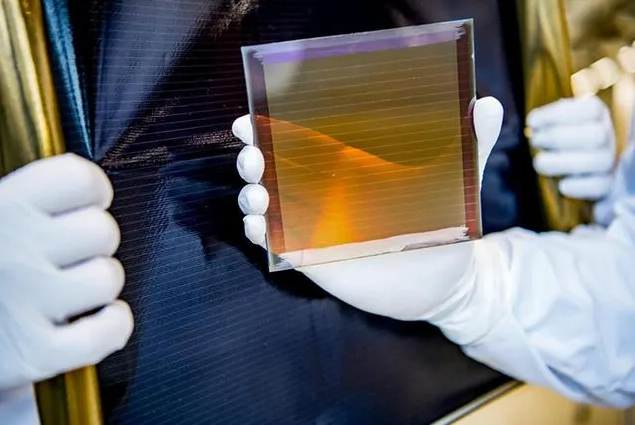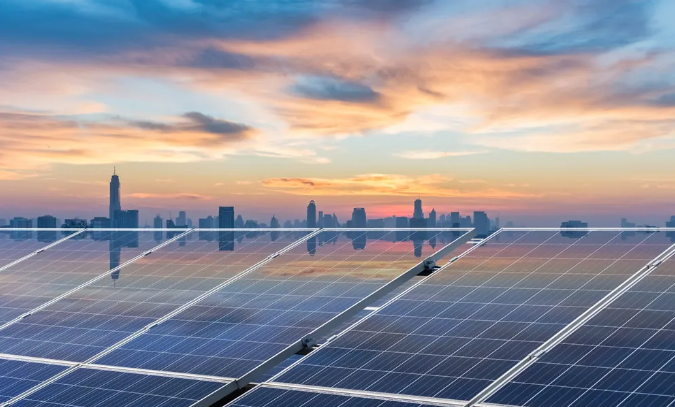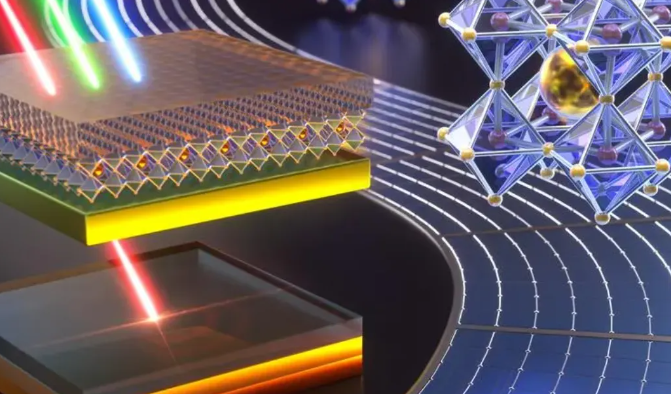Nov 15 , 2024
In today's era of rapid technological development, the research and application of new materials have become a key force driving progress in various fields. Perovskite is the representative of third-generation solar cells: In the past 60 years, three generations of solar cells have been developed.
The first generation is a solar cell based on silicon material, which is currently the most mature mainstream commercial cell;
The second generation is thin-film solar cells, represented by copper indium gallium selenide (CIGS) and cadmium telluride (CdTe) cells. Compared with the first generation, it has the advantages of thin thickness and high photoelectric conversion efficiency. However, some factors also limit the development of such cells, such as rare or toxic material reserves and complex preparation processes;
The third generation is a new type of solar cell, mainly including perovskite solar cells, dye-sensitized solar cells, organic solar cells, and quantum dot solar cells. Perovskite, as a material with unique structure and excellent properties, has shown great potential in many fields and has attracted widespread attention from the scientific and industrial communities.
The name perovskite is derived from the name of Russian mineralogist Perovski, and its structure ABX3 and similar crystals are collectively referred to as perovskite minerals.
Among them, A is usually an organic cation (such as methylamine ion, methylamine ion, etc.) or an inorganic cation (such as cesium ion), B is a divalent metal cation (such as lead ion, tin ion, etc.), and X is a halogen anion (such as chlorine, bromine, iodine). This unique structure endows perovskite materials with excellent optoelectronic properties. It is a third-generation solar cell that uses perovskite type organic metal halide semiconductors as light absorbing materials.

Perovskite solar cell structure: five layer basic structure
The basic structure of perovskite solar cells is a five layer "sandwich" structure, with a perovskite layer as the center, two transport layers on the upper and lower sides, and two electrode layers on the outermost side.
Taking a single junction planar perovskite cell as an example, from bottom to top are: glass, transparent electrode (FTO, ITO or FTO), electron transport layer, perovskite layer, hole transport layer, and metal electrode.
When light is irradiated onto perovskite materials, photons are absorbed, exciting electrons to transition from the valence band to the conduction band, forming electron hole pairs. Under the action of an internal electric field, electrons and holes are respectively transported to the cathode and anode, generating current and achieving photoelectric conversion.
(1) Calcium titanium ore layer absorbs light energy and generates excitons (carrier pairs) inside;
(2) The electron transport layer efficiently transports electrons to the electrode and blocks holes from moving towards the outer electrode, achieving carrier separation and preventing direct contact between the perovskite layer and the electrode and internal short circuits;
(3) The hole transport layer efficiently transports holes to the electrode while blocking electrons from moving towards the outer electrode, achieving carrier separation;
(4) The electrode layer extracts electrons and holes on both sides and is connected to an external circuit. The side facing the direction of light is the bottom electrode, and the other side is the top or back electrode.
In recent years, perovskite cells without hole/electron transport layers have also been gradually studied in depth. Battery structures can be divided into three categories: planar formal, planar trans, and mesoporous structures. According to whether the perovskite film grows on the TiO2 mesoporous support layer, it can be divided into mesoporous structure and planar structure. The former is the most common structure in the early stage of perovskite cell development, and the order of each layer according to the direction of receiving light is "bottom electrode/electron transport layer/perovskite layer/hole transport layer/top electrode".
Later researchers realized that semiconductor scaffolds were not necessary, so they developed planar structures. The formal planar structure had the same order of functional layers as the mesoporous structure, which can be represented as "n-i-p". The advantage is that it can achieve high laboratory efficiency. In the trans structure, the order of the two transport layers is reversed, which is represented as "p-i-n". Its characteristic is that the entire preparation process can be completed under low temperature conditions, and the material structure stability is stronger. It is currently the focus of industrial research.
Perovskite cells have a relatively wide range of optional materials for each functional layer, and different requirements are generally considered for combination. There is a wide range of material systems available for perovskite batteries, with different types of materials for each functional layer. However, in order to achieve ideal battery efficiency, there needs to be good energy level matching between the layers,Then it is necessary to consider factors such as material stability and cost:
(1) In terms of perovskite layers, in order to form a basic stable structure, the effective ion radius ratio of A, B, and X ions needs to meet specific tolerance factor conditions. Based on whether the A site is an organic ion, it can be divided into organic-inorganic hybrid perovskites and all inorganic perovskites. The former has good comprehensive performance and is widely used, while the latter has good thermal stability but lower efficiency.
(2) In terms of hole transport layer, organic small molecule spiro OMeTAD is widely used due to its good energy level matching with perovskite layers.
(3) In terms of electronic transport layer, organic materials such as graphene and PCBM have good energy level matching, but their stability is poor. Metal oxides such as TiO2 and SnO2 are widely used in practice. 4) In terms of electrode layer, the bottom electrode needs to have transparency, usually using TCO glass such as ITO and FTO. The top electrode laboratory often uses metal Au with good conductivity, but it is expensive. Using TCO is beneficial for making double-sided power generation structures. Carbon materials have also become a good choice due to their low price and good performance.
Preparation of perovskite layer thin film
Solution method (wet preparation)
(1) One step solution method: Dissolve organic and inorganic sources in a certain proportion in an organic solvent to prepare a precursor solution. Then, drop the prepared precursor solution onto the substrate for spin coating. During the spin coating process, excess solvent will be thrown away, leaving a certain thickness of precursor liquid film on the substrate. The desired organic-inorganic hybrid perovskite film can be obtained by natural drying.
(2) Two step solution method: In the film formation process of perovskite, the two-step method is relatively easy to prepare fully covered film layers due to its good controllability and high repeatability.
Gas phase method (dry method preparation)
(1) Dual source co evaporation method: The dual source co evaporation method is equivalent to a one-step solution preparation method, but the two materials exist in the gas phase and react uniformly. Two sets of evaporation sources, one for evaporating PbCl2 and the other for evaporating CH3NH3I. Two materials are deposited together on the substrate to form a perovskite thin film.
(2) Single source evaporation method: The single source co evaporation method uses PbX2 and MAX as two separate sources for simultaneous evaporation to achieve vacuum deposition. Therefore, single source evaporation requires the use of instant evaporation method, which instantly increases the material temperature to the evaporation temperature, allowing the material to evaporate and deposit on the substrate.
(3) Stepwise vapor deposition method: Professor Lin Haowu's team at National Tsing Hua University in Taiwan used a vacuum evaporation chamber for stepwise vapor deposition.
Firstly, a layer of PbCl2 film is vacuum deposited, and then CH3NH3I is evaporated at a source temperature of 85 ℃. Under a vacuum environment of about 10-4Pa, the crystal quality and device efficiency of thin films with different substrate temperatures were compared, and it was found that the sample with the largest grain size was prepared when the substrate temperature was 75 ℃.
Gas assisted solution method (wet dry combined method)
Firstly, PbI2 thin film is prepared by spin coating, and then the film is exposed to CH3NH3I steam at 150 ℃ for annealing. As the annealing time increases, CH3NH3I diffuses into the PbI2 film and reacts to generate CH3NH3PbI3.
In the two-step solution method, solute re dissolution occurs, which often leads to the re dissolution of perovskite films and damages their density over a long period of time. The use of gas-phase method can avoid this process. Research has found that after 2 hours of gas-phase reaction, PbI2 can be completely converted to CH3NH3PbI3, and increasing annealing time has no further effect on the film structure.

Selection of perovskite whole line equipment
Taking the most commonly used trans battery structure (TCO-HTL perovskite active layer ETL electrode) as an example: Transparent conductive oxide (TCO) layer: TCO conductive glass includes ITO, FTO, AZO coated glass, which use tin doped indium oxide (In2O3), fluorine doped tin oxide SnO2), and aluminum doped zinc oxide (ZnO) as target materials, respectively.
TCO preparation can be roughly divided into two methods: online and offline coating. Online coating is the installation of coating equipment above the tin bath in the float glass production line, usually using APCVD (atmospheric pressure chemical vapor deposition) process for coating.
Offline coating is the process of cleaning and preheating ultra white floating glass, coating it with PVD (Physical Vapor Deposition, usually magnetron sputtering technology), and then cooling and etching to complete the coating. FTO online coating technology is relatively mature, but the equipment price is relatively expensive; ITO and AZO are usually coated offline, and magnetron sputtering technology is very mature.
Transport layer: mainly dry vacuum coating
Vacuum coating is a relatively mainstream manufacturing method for the transport layer of perovskite cells. The materials available for the transport layer are relatively diverse, but considering industrial production,In addition to having good carrier transport capability, it is also necessary to consider the stability of long-term use, the availability of materials, and the process conditions for large-scale production.PVD and RPD are currently the mainstream methods for producing transport layers in vacuum coating dry processes。
Magnetron Sputtering Physical Vapor Deposition (PVD): It involves ionizing low-pressure argon gas into argon ions (Ar+) and electrons in a vacuum where the electric and magnetic fields are perpendicular to each other,Under the action of a magnetic field, argon ions fly towards the target material. After being impacted, the target atoms break free from their original lattice constraints and vaporize, gradually adsorbing onto the substrate surface to deposit a film. Its characteristics are:
(1) Relatively mature technology, capable of sputtering a wide range of materials
(2) Fast and uniform film formation, capable of large-area film formation,
(3) The utilization rate of target materials is relatively low, generally less than 40%,
Reactive Plasma Deposition (RPD): Essentially, it is also a type of PVD, but it involves emitting a plasma stream from a plasma generator, which is deflected by a magnetic field and directed onto a target material in a crucible, causing it to sublime and deposit onto a substrate. Its characteristics are:
(1) During the coating process, the particle energy is small to avoid substrate damage;
(2) Can deposit high-quality thin films under relatively low temperature conditions;
(3) The utilization of raw materials is relatively high;
(4)The technological barriers are relatively high.
PVD is a better choice for the industrial production of hole transport layers. Due to the high stability requirements for industrialized production of perovskite cells, adopting a p-i-n trans structure would be more suitable,The use of inorganic materials with high stability, such as nickel oxide NiO, is relatively suitable for the hole transport layer. Therefore, PVD is a good choice for producing uniform and dense thin films.
The industrial production of electronic transport layers currently uses RPD, which is relatively better. Inorganic metal oxides are also suitable choices for the electron transport layer of industrialized perovskite cells,Thin film layers such as TiO2, ZnO, and SnO2 can be fabricated using dry methods. As the electron transport layer in the trans structure is fabricated on top of the perovskite layer, it is necessary to prevent damage to the perovskite layer. Therefore, RPD has become an advantageous choice.
Electrode layer: mainly using TCO material, PVD sputtering is the main method
Directly use industrialized TCO coated glass as the substrate, with the bottom electrode layer prefabricated on the glass plate.Perovskite single junction cells are made based on transparent glass plates, and the bottom layer requires transparent electrodes that can transmit light,Therefore, transparent conductive oxide (TCO) coated glass can be directly used as the substrate, that is, a glass plate with a TCO film layer coated on the surface.
There are many methods for preparing NiOx, among which magnetron sputtering PVD has uniform film formation, controllable film thickness, and good repeatability; The atomic layer deposition (ALD) method has precise thickness control, resulting in extremely smooth and uniform thin films with high repeatability.In addition, previous researchers have also used the solution method to prepare NiOx nanoparticle dispersion and the spin coating process to prepare NiOx hole transport layer thin films,However, its preparation process usually requires high-temperature annealing, and the quality of its thin film is sensitive to synthesis conditions, resulting in poor reproducibility.
More importantly, by utilizing existing large-area film preparation techniques such as slit coating, spray coating, and inkjet printing,Preparation of thin films with nanoscale thickness based on solution method,It is prone to a large number of physical defects such as pinholes caused by bubbles, insoluble particles, or surface non wetting areas, which cannot achieve uniform coverage over a large area.
Calcium titanium ore layer: generally wet method (coating machine), and in some cases, dry method (vacuum evaporation) is also used,(Electronic Transport Layer (ETL): Metal oxides such as TiO2, ZnO, SnO2 are commonly used inorganic electronic transport materials, which have the advantages of tunable bandgap, high transmittance, and strong carrier transport ability.
Electrode layer: Materials include metal and non-metal, which can be selected according to device type and experimental needs.Metal electrodes are generally deposited by vacuum evaporation with a thickness of about 80nm.In single-cell devices, electrode materials often use noble metals with good conductivity, such as Au, to control costs. Metal Cu or Al may also be used as substitutes.

Perovskite/Crystalline Silicon Stacked Battery
Current crystalline silicon battery
Crystalline silicon cell technology uses silicon wafers as substrates and is classified into P-type cells and N-type cells based on the differences in silicon wafers. There is no essential difference in the power generation principle between the two types of batteries, both of which rely on PN junction for photogenerated carrier separation.
The solar cell with n+/p structure formed by diffusing phosphorus element on P-type semiconductor material is called P-type cell; Injecting boron element into N-type semiconductor materials,The solar cell that forms a p+/n structure is called an N-type cell.The production process of P-type batteries is relatively simple and cost-effective, and currently PERC is the mainstream.
HJT (Heterojunction with Intrinsic Thin Film) - Intrinsic Thin Film Heterojunction Battery.Featuring a symmetrical double-sided battery structure with N-type crystalline silicon in the middle. Deposition of intrinsic amorphous silicon film and P-type amorphous silicon film in sequence on the front side forms a P-N junction.
On the back, intrinsic amorphous silicon thin film and N-type amorphous silicon thin film are sequentially deposited to form a back surface field.Due to the poor conductivity of amorphous silicon, transparent conductive films (TCO) are deposited on both sides of the battery for conductivity, and finally screen printing technology is used to form double-sided electrodes.
Perovskite crystal silicon stacked cell
Pure perovskite cell structure: Currently, perovskite cells are divided into two types: single junction perovskite and stacked perovskite.Pure perovskite cells can be divided into two device structures: n-i-p and p-i-n. The n-i-p structure refers to the device structure of electron transport layer perovskite layer hole transport layer,The p-i-n structure refers to the device structure of hole transport layer perovskite layer electron transport layer, among which the n-i-p device structure is more common.
Stacked perovskite cell structure: The continuously adjustable bandgap width makes perovskite suitable for making stacked multi junction cells. The advantage is that other types of solar cells can capture and convert a wider spectral range of sunlight after integration, improving cell conversion efficiency.The technical directions of stacking mainly fall into two categories: perovskite/crystalline silicon stacked batteries and perovskite/perovskite stacked batteries.
The perovskite/silicon series solar cell combines the advantages of crystalline silicon and thin film cells, and through the combination, broadens the absorption spectrum, achieving higher photoelectric conversion efficiency than pure crystalline silicon cells or perovskite cells.
From the perspective of process difficulty, the easiest to achieve is the four terminal stacked battery with mechanical stacking.The two sub cells of the four terminal stacked battery are independently manufactured, and the two sub cells are only optically connected,The circuits are independent of each other, so the optimal manufacturing conditions for the two sub batteries can be designed separately, and the two sub batteries can operate independently at their maximum power points.
Two end stacked cells are made by directly depositing perovskite cells on silicon cells, and two sub cells are connected in series through composite layers or tunnel junctions.Compared with mechanically stacked four terminal batteries, this two terminal architecture only requires one transparent electrode. Due to less electrode material usage and fewer deposition steps, the manufacturing cost of the two terminal battery is greatly reduced.
This is the first one.
This is the last one.